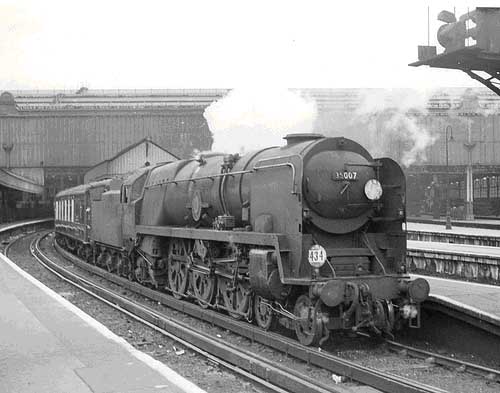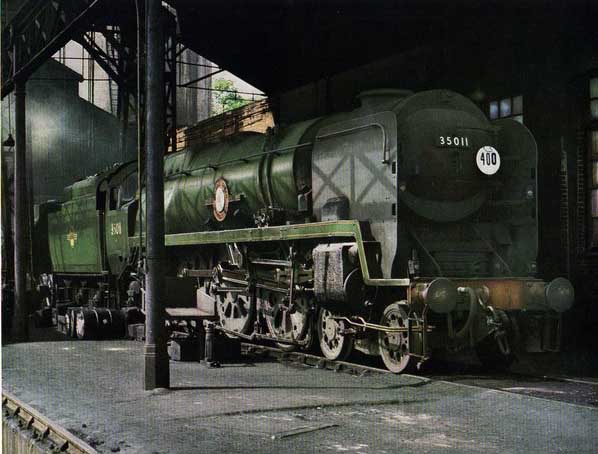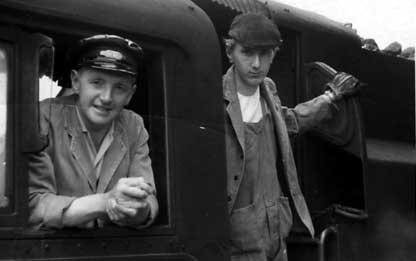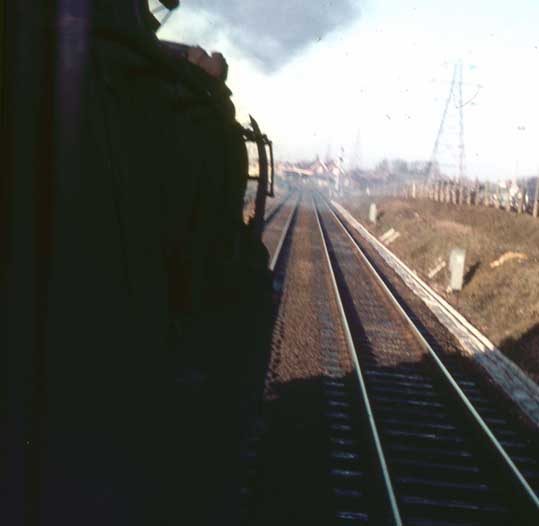
Alan Newman Nine Elms Engineman 1st January 1962 - 8th July 1967
A MERCHANT NAVY PACIFIC'S FINEST HOURThe Train 'The Royal Wessex'Driver A E Hooker Nine Elms Locomotive 35011 'General Steam Navigation' A regular duty at Nine Elms for No 2 Link was the 2.45am Waterloo to Bournemouth West paper train. The return train was the Up Royal Wessex departing Bournemouth Central at 8.40am. stopping at Brockenhurst, Southampton Central and Winchester City, due to arrive Waterloo at 10.53am. I worked the Up Wessex with my regular mate Driver Bert Hooker over thirty times in my time with him, but one trip stands out from the others. In August 1965 we had 35011 with 12=404 tons behind the tender. I was enjoying a good trip. We made our final stop at Winchester, where the starting signal remained 'On' I then saw the Station Master walking from the signal box. The Station Master came up to the cab and infomed Bert, that a freight train had failed between Winchester Jct and Wallers Ash tunnel. Control wanted us to unhook and go forward light engine to assist the failed train into Wallers Ash loop. The plan was to clear the failed train into Wallers Ash Loop then to return wrong road and get our own train. Bert said the job would be better done taking our own train, the extra weight would add to the momentum, for starting on the 1/250 gradient. Bert was always up for a challenge! We duly set off to the point where the failed train was standing, just past Winchester Jct.. We stopped initially to pick the guard up who had walked back putting his detonators down as protection. Bert stopped 35011 about 10 feet short of the failed train. The fireman (Alec Jones of Eastleigh) was waiting in the Guards brake van. Alec informed Bert that all the brakes apart from the brake van were fully released. The failed train had a type 33 diesel with 60 empty van fits plus a Guards Brake van. Bert told Alec to release the hand brake when the buffers were about 8 -10 inches apart. Bert sounded the whistle code (1 Crow) to alert the driver on the Diesel and duly eased 35011 into forward motion we gently eased onto the rear as soon as the buffers came into contact the momentum started the whole ensemble up the bank. We were soon up to 15/18 mph Bert working 35011 at 50% cut off. For my part we had 250 psi steam and just over 1/2 a glass of water. Bert encouraged 35011 into action saying "come on old girl do it for Gaffer Gilmore" whose regular engine she was when brand new at Nine Elms. On clearing the failed train into Wallers Ash Loop Bert stopped then waited while Alec secured the failed train with the hand brake. Bert eased 35011 back and stopped making sure the hand brake was holding the failed train, and it did not follow us out of the loop. The Wallers Ash signalman gave us a green hand signal as authority to drop out of the loop and we stopped behind his home signal. The signalman set the road and cleared his Up signals. The rest of the trip was bit of anti climax, and Waterloo was reached just 30 minutes late. It a shame the event was not captured on film, Bert said it was probably the heaviest train a Merchant Navy ever tackled. Bert estimated the total weight to be around 1,200 tons. All started on a 1/250 rising gradient without a slip, Bert was indeed the Driver for such occasions. Alan Newman Nine Elms Engineman 1962-1967
MY FINEST TRIP 35007 at Waterloo August 1965 Photo copyright Alan Newman collection In October 1964 I was promoted to No2 link with Bert Hooker I was just 17 years old. My previous driver in No 3 link had been George Enticknap, whose way of handling a locomotive had been some what different to the Bert Hooker approach, but I soon learnt. A regular turn in No 2 link was the 0830 Waterloo - Weymouth which we worked as far as Bournemouth. The following is my account of a trip we made in the first week of September 1965. We signed on duty at 0656 at Nine Elms on perusal of the Engine arrangements sheet we were allocated 35007 which was in the new shed. I went to the engine and checked we had all the required tools, I then went to the stores and collected the oil and a supply of brown and white clothes. On my return to the engine Bert had arrived and we got on with preparing the engine. I made up the fire and Bert attended to the oiling. With oiling done and the fire made. We moved 35007 back over the pit where the boiler blow down was operated; I then cleaned the boiler back plate and washed down the foot plate.
We dropped back to the turn table and then onto No 1 pit road we stopped at the water column and filled the tender, then moved under the coal hopper. I then went to make the coffee while Bert trimmed the coal on the tender. I was usually allowed to drive the engine to Waterloo, the normal arrangement was to couple in the Waterloo siding to the engine for the 0835 Bournemouth. The fireman of the 0835, engine had which left the loco just before us, coupled up. We then run coupled tender first to Waterloo, stopping at the Home signal on the Up Relief line. As we were the leading engine it was my job to uncouple. We then moved on to our train which was standing at platform 11. I coupled 35007 to our train which consisted of 11 coaches. Our guard waited on the platform as I coupled up he then went to speak with Bert and advise him of the load, and then carried at the brake test. The time was 0820 and a gentleman approached 35007 who greeted Bert, the chap turned out to be Mr G Sands the assistant Motive Power officer. Mr Sands was travelling to Southampton with two colleagues for a meeting. Bert duly invited Mr Sands to ride on the footplate, assuring him he would not get dirty on the trip.
At 0830 we departed next stop was to be Southampton Central. As we passed over Westminster Road Bridge I started the injector and sat down until Bert shut off steam for Clapham Jct. At this point I shut off the injector and cracked open the fire hole door. With the speed at the permitted 40mph Bert set the cut off at 27% opened the regulator with 180psi indicated in the steam chest, I started my firing, the boiler pressure was about 210psi. On the climb to Earlsfield the boiler pressure was up to 250psi the water level showing about ¾ of a glass I started the injector. This was my normal approach, since being with Bert I had adopted the little and often approach to firing, keeping the floor clean and the making good use of the tender spay, thus avoiding dust in the cab.
It was soon evident that 35007 was in very good nick, and was making light work of the 11 coach load. Bert was working 35007 at between 20/25% cut off with 180psi in the steam chest. Between Walton on Thames and Oatlands signal box 35007 lifted the safety valve, I responded by closing the back damper to about ½ open. We had a very good run with the boiler pressure being maintained very close to 250psi red line. At Michledever Bert eased the regulator for the run down the bank, I fully closed the back damper. The boiler pressure responded and I maintained about 200psi.on the run down through Winchester. We suffered the customary signal check at Eastleigh thus arriving at Southampton Central some 3 minutes late. Mr Sands departed thankfully still clean as when he stepped on the footplate at Waterloo. I put the pipe in, with the tender full I returned to the foot plate, in all this time 35007 had not made a single pound of steam, the pressure gauge still indicated 200lbs. I opened the back damper in readiness to set off for Bournemouth. Off we went and 35007 soon responded to my firing, the boiler pressure was back to the red line by the time we passed Millbrook. After passing Brockenhurst I worked a little harder to build a bigger fire in readiness for our relief at Bournemouth. We arrived at Bournemouth on time, as we alighted from 35007 Bert turned to me and said "Alan one day some one will ask you to describe the perfect firing trip, you will remember this day, as it truly was the perfect trip" Bert added it was made even sweeter because Mr Sands was of Eastern region blood, and on leaving us at Southampton, he said to Bert that 35007's performance that day was as good, if not better than any trip he had with an A4! If only every day was like that. Copyright 2009 © Alan Newman - Nine Elms - Southern Engineman
Here is an email discussion between Alan Newman and Jim Arkell which was prompted by Alan's article above.
Jim Arkell has written:
Jim Arkell later added: Orginally the LT&S which of course was Midland anyway. Geoff and Bill became quite friendly with Bill Harvey who was at Norwich, and sorted the Britannias out in the 50's. I'm not sure if you'd know, but they weren't very good when they first came out. Bad valve events, wheels coming loose, and motion off for re-bushing every weekend in some cases. The two that were at Stew lane were there for political reasons at the behest of Stewart Cox, who didn't like Bulleid at all. I've been told that was because they both applied for the job as Gresleys assistant, and Bulleid got it. Geoff Sands was in the process of getting the J15 going at Bressingham when he became ill and died. My contact also believes that Geoff Sands was at Salisbury, and he knows the story about 35010 which he got from Geoff's own lips, who apparently said to him that it was the best engine they had at Salisbury. I had to point out it was never a Salisbury engine. But of course the Exmouth Jnc engines did the same range of jobs, so he would have known it anyway. He thinks that Geoff was at Salisbury at the time that 35010 broke a cylinder. But that doesn't quite square with Alan Newmans account, because it was in 1966 that happened. I remember the engine was at Nine Elms afterwards with motion still on. In fact Bert Hooker took some photos of it like that, and I have copies of those somewhere that he gave me.
Alan Newman replied: I do not doubt that in better times she was a good engine as all the Exmouth Jnc engines had good reputations, but by the time I started to get on them it was late 1963 early 1964 when they were passed their best.
Jim Arkell added: I've picked up odd snippets of information over the years about different engines. Particularly MN's. For example 35012 developed a leak in the boiler barrel, which resulted in it being withdrawn. 35007 & 35026 were kept going by swapping wheelsets with withdrawn engines, 35022 & 35011 respectively. Only for 35026 to be withdrawn a few months later with a loose tyre. Whilst there are people still around who remember these things, I think it's a good idea to collect and record such things.
Alan Newman further replied: You were right about 35011 being a strong engine, we were working the Up Wessex with 12 on. We stopped as normal at Winchester where we were told that a freight train had failed between Winchester Jct and Wallers Ash tunnel. We were advised by control to unhook and go forward light engine to assist the failed train into Wallers Ash loop. The plan being to return wrong road and get our train. Bert said the job would be better done without unhooking and that we would take our train with us. Bert was always up for a challenge. We duly set off to where the failed train was stuck just around the curve from Winchester Jct. Bert stopped about 10 foot short of the train, this after we had stopped initially to pick the guard up who had walked back putting his detonators down as protection. The fireman of the failed train was waiting in the Guards brake. (Alec Jones of Eastleigh) he told Bert that all the brakes apart from the brake van were fully released. The failed train had a type 33 diesel and 60 empty vanfits + guards van. Bert told Alec to release the hand brake when the buffers were about 8 - 10 inches apart. Bert duly sounded the whistle and eased 35011 into forward motion we gently eased onto the rear of the failed train. As soon as the buffers came into contact the momentum started the whole ensemble up the bank. We were soon up to 15 mph Bert working 35011 at 50% cut-off. For my part we had 250 psi steam and just over 1/2 a glass of water. Bert encouraged 35011 into action saying "come on old girl do it for Gaffa Gillmore" whose regular engine she was when brand new at Nine Elms. It a shame the event was not captured on film, Bert said it was probably the heaviest train a Merchant Navy ever tackled. Bert estimated the total weight to be over 1,000 tons. All started with out a slip, on a rising gradient Bert was indeed the Driver for such occasions. I am note sure if 34060 was Bert's favourite small Bulleid but he did indeed have it when it was brand new, his regular MN 35020 was having its first major overhaul. For the record my favourite was 35012 if only because I had more trips with her than any other. She was not the fastest that was definitely 35020, but 35012 was the best all round in my opinion. The most popular MN amongst Nine Elms chaps in my time was with out doubt 35022.
More comments from Jim Arkell: On a long return trip from a steam special over the long drag one time, a group of us including Bert were discussing the Bulleids and which ones were good, and not so good. He was quite in favour of 34060, and I think that was the first time I heard the story about the up train that was stopped at Queens Road and the driver relieved and put on shunting. Bert said the engine was 34060 when it was new. Alan Cook used to front up occasionally on those trips - in the early 80's - and he insisted on calling 35012 the leg chopper. Talking of nicknames, have you any idea why 35023 was called the pram? 35012 in fact holds something of a record between Appleby and Ais Gill when Bert did a trip with it in June 1964. We got quite close to his time on a couple of occasions with 46229, but his record is safe I think. The engine might have made it to the end, but it was failed by Jack Finch at Nine Elms with a leaking barrel joint on the boiler a couple of months into 1967. I hadn't realised 35022 was so popular. It has survived, but I'm not sure what its future is now. In the last few months I heard more about 35008 being a favoured one, although 22 had gone by then. One of the longer standing members of MNLPS said many years ago that their original target was 35017, and when that went, 35022. Finally 35028, because it was the last one through works to get a fresh boiler, and supposedly a fast engine although most people said 35003 was faster. Something I found out only a few weeks ago was that the last two boilers removed from engines 35027/8 were actually repaired to go on engines but were scrapped without being used again. The railway really knew how to waste money.
Malcolm Peakman emailed: I read the mentions of Geoff Sands. I met him at Crewe in 1963? on the occasion of a visit of a Bulleid to Crewe. Geoff was the shedmaster at Crewe North and he showed us (a group from Derby Loco) not only the Bulleid, but his pride and joy - his "Big Lizzies" (Duchesses). He was very critical, by the way, of the LNW practice of carrying high water levels in the Big Lizzies, I remember his comments on how it caused cutting of the valve seats in the fountain and injector steam valves. I must also mention that years later I learned his nickname at Crewe - which wasn't very complimentary, and from which I assume that he wasn't a local man. It was "shifting Sands".
Jim 'The Spring' O'Halloran emailed: I feel I must reply to Jim Arkell's comments on the W.R. Sending it's "worst diesels" to work the Waterloo to Exeter services. The B.R.B. had decreed that the Southern route from London to the West of England was to be secondary to the Western route. The locomotives nominated were the 800 class warships, but not the 833 class. The 800 which although not the W.R. Flagship 1000 class were one of the many first generation locos from the 1955 modernisation plan. During my apprenticeship in my time at Hither Green a topic of conversation that regularly cropped up was the high failure rate of these locos with the knock on effect to the Bournemouth/Weymouth services due to bumping up of the next available loco this spurred my curiosity as to why the failure rate of said locos was so high and having made a formal request I was granted one month with Jack Gardner the fitter at Waterloo so I could satisfy my curiosity, as events turned out I managed to wangle another three months unofficially. As it soon became evident the major cause of loco failure was on instruction from D.M.O. That in cold weather a loco without steam heat was not to work a passenger train. The two types of steam heat were either a Spanner diesel fired boiler or a Stones Steam Generator. The Spanner Boiler was shall I say a temperamental device but as a rule could be persuaded to work the S.S.G. Although more reliable did have a tendency from time to time to develop a blocked coil which could only be rectified by a chemical washout at a depot with such facilities this could also be aggravated by operators not carrying out the correct start up and shut down procedures. As things transpired jack Gardner left the railway early in 1969 and I was lucky enough to be appointed as his successor, (quiet an act to follow) which I remained at till after the 800's were replaced by class 33's in October 1971. The locos that were sent to Waterloo on these services were a fare cross section of the class ranging from a loco basically ex works to a loco on its last duty prior to going to works for a complete overhaul. The 800 and 833 classes of locos were based on the German class V200's which were built to a larger loading gauge also I suspect that they were only run at a maximum speed of 100 K.P.H. but I am open to correction on that statement. The loading gauge led to a more cramped version of design and the higher running speed on a railway only maintained to a secondary line standard was not conducive to successful everyday running. I can definitely state that a loco that had started from Newton Abbot prior to working to Waterloo was to be found in a pretty good condition, however locos that had been elsewhere than N.A. at times left things to be desired. I also found that a Newton Abbot loco was a better machine than a Laira loco, the two depots that the 800 class were allocated, to further counter the comment on the worst locos sent to The Southern the 833's were the first to be withdrawn with all of its survivors withdrawn in October 1971 the remaining 800's being withdrawn at a later date. I make no excuses for making myself a thorn in the side of the local operating departments who used to rant and rave about the importance of a right time start, after all there job was done when the train left Waterloo and my job was done when it got to Exeter. I also estimate that if I had not done the job the way I did about the same amount of trains would have left with an 800 at its head but a lot more made it to Exeter because it did not leave until I was satisfied with its condition.
|
|
Site sponsored/maintained by SVSFilm © 2012 ... Go to SVS Film Index Go to Nine Elms Main Index - "Light to Loco" |



